Develop a Stochastic Method to Generate Ballistic System Specifications for MCS
Info: 6035 words (24 pages) Example Dissertation Proposal
Published: 19th Nov 2021
Tagged: Sciences
Abstract
As the advancement of applied statistical techniques in the field of science and engineering, the predication of mathematical models’ outcomes can be provided. Applying stochastic process to the mathematical IB model can identify a good estimation of the MCS parameters. Therefore, understanding of the internal ballistics system behaviour and propellant characterisation is required to match the parameters predictions through the statistical process. First to do is to identify the suitable type of stochastic modelling system that can fit to the specified mathematical model followed by implementation of the system to the internal ballistics model. Thus, such a system would be used to serve as a tool to provide the capability for the systems engineer to predict and determine MCS performance parameters and develop ballistic specifications. Matching the data of the stochastic model with the literature outcomes results in the adequate desire of the study.
Click to expand Table of Contents
Table of contents
1 Background to study
2 Problem Statement
3 Literature Study
3.1 Survey on different types of internal ballistics models
3.1.1 Properties of modern internal ballistics models
3.1.2 Internal ballistics models as diagnostic tools
3.2 Sensitivity analysis to several ballistic parameters of MCS
3.2.1 Charge weight
3.2.2 Propellant size
3.2.3 Propellant shape
3.2.4 Sensitivity correlation to different IB system parameters
3.3 Methodological assumptions
3.3.1 Selection of appropriate PDF
3.3.2 Evaluation of selected PDF
3.3.3 Estimation of distribution parameters
4 Research aim and objectives
4.1 Research aim
4.2 Research objectives
5 Research methodology
5.1 Study context
5.2 Data collection
Ethical considerations
Permission and informed consent
Anonymity
Confidentiality
List of Tables
Figure 1.1: Typical IB cycle
Figure 1.2: Charge propellant grains configuration
Figure 1.3: MCS loading and firing schemes
Figure 3.1‑1: Percentage error of equilibrium and thermodynamic models (Miner, 2008)
Figure 3.1.1‑2: Representations of different IB models (Horst & Nusca, 2006)
Figure 3.2.1‑1: Variation in charge weight (DoD, 1992)
Figure 3.2.1‑2: Effect of variations of charge weight (Bougamra & Lu, 2014)
Figure 3.6: Variation in grain size (DoD, 1992)
Figure 3.2‑3:Variations in grain shape (DoD, 1992)
Figure 3.2.5: Sensitivity correlation to different IB system parameters
List of Figures
Figure 1.1: Typical IB cycle
Figure 1.2: Charge propellant grains configuration
Figure 1.3: MCS loading and firing schemes
Figure 3.1‑1: Percentage error of equilibrium and thermodynamic models (Miner, 2008)
Figure 3.1.1‑2: Representations of different IB models (Horst & Nusca, 2006)
Figure 3.2.1‑1: Variation in charge weight (DoD, 1992)
Figure 3.2.1‑2: Effect of variations of charge weight (Bougamra & Lu, 2014)
Figure 3.6: Variation in grain size (DoD, 1992)
Figure 3.2‑3:Variations in grain shape (DoD, 1992)
Figure 3.2.5: Sensitivity correlation to different IB system parameters
1 Background to study
The science of internal ballistics is the study of phenomena of chemical combustion of propellants and dynamic movement of the projectile within the gun. The internal ballistic cycle of gun launched systems comprises the steps from striking of the firing pin on the percussion cap up to the point where the projectile leaves the muzzle of a barrel with a certain muzzle velocity. (I.e. 155mm artillery, mortar bombs, 40mm, etc.) The following design objectives are generic for gun launched systems:
- Maximizing Muzzle Velocity to Peak Pressure ratio. Apart from chemical composition, to meet the specifications of the propulsion system.
- Ensure complete burnout inside the barrel to prevent slivers (unburnt propellant), to increase the gun service life. The all-burnt point is a function of the operating pressure / burn rate and propellant geometries.

Figure 1-1 describes a typical IB cycle where AB is All-Burnt point, d is bore diameter, mpis the projectile mass, and L is the barrel length.
Due to the short duration of the internal ballistic cycle in gun-launched applications that may reach milliseconds, performance analysis is a major challenge, especially the accuracy of absolute pressure levels. Therefore, comparative parameters performance is the norm in gun propulsion systems.
The shaping of the characteristic pressure-time curve for a gun system is dependent on the burning behaviour and several other propellant’s grain characteristics (e.g. grain size and shape) of the propellant acting simultaneously with charge system characteristics, (e.g. charge mass, loading density). All of these will have an influence on the pressure-time curve. So that, all aspects must be considered during the charge design for optimum performance for every weapon system. Once the design is fixed it is the responsibility of the manufacturer to ensure that minimum variation occurs in terms of chemical composition, physical characteristics and dimensions to ensure a product of reliable performance.
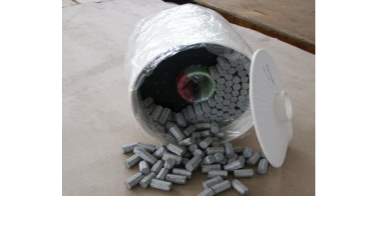
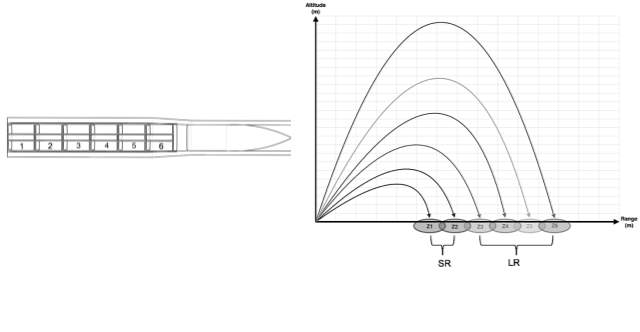
MCS systems operate at maximum velocity of 800 to 1000 m/s and propellants are typically triple base of extruded multi perforated configuration. Propellants are packaged into combustible case modules as illustrated above in figure 1.2. Each charge module contains at least 4-5 different combustible compositions. It is therefore a bit more complicated to simulate, but the standard simulation models can be adapted to handle multiple propellants and be utilized with good success. The modular charge system configuration, to yield a range of velocities, presents a unique design and operational challenges to developers. The simulation models for the charge configurations will be investigated and developed in detail in this research.
It is obvious that a good and reliable internal ballistic simulation tool would be valuable to support a design team in specifying and developing a modular charge system as illustrated above. Without such a tool, many design iterations would most probably have to be performed by repeating many dynamic firing tests, which could be costly and time consuming.
2 Problem Statement
Modular Charge Systems (MCS) present a challenge to the Ballistic Systems Engineer in terms of determining the ballistic specifications over all the Charge Zones. Normal variations in propellant vivacity, charge mass and other parameters during production may result in varying sensitivities in the lower zones, which could result in the product moving outside the specification. Anticipation of these variations may have not been covered during the development phase, due to the requirement for elaborate testing which places pressure on development costs.
To predict variations in ballistic performance over all the MCS charge zones, inputs variability within the typical specification limits should be covered. This will enable the design team to establish ballistic system specifications, in manufacturing (input) as well as performance (output), during the development phases of a project, without the need of elaborate and extensive testing and verification. This capability will reduce the risk of possible failing ballistic performance specifications during the product life cycle.
3 Literature Study
As the technology in the ordnance sector develops, a wide range of theoretical and applied studies have been published. Especially the analytical and numerical models in internal ballistics that represent the science behind the projectile launching have been improved in order to get optimum results. One challenge of the proposed study is to select an internal ballistic model with minimal shortcomings and higher accuracy which can be applied to MCS. Therefore, a survey on different types of IB models have been conducted.
The accuracy of internal ballistic systems is categorically enhanced by studying the effect of each input on the exit velocity, the maximum pressure and the exit shot time. These inputs will be categorised and reviewed in this literature study, and their degree of influence to the IB system determined. When studying any parametric sensitivity, the correlation of the input parameter to the output define the degree of its influence. As a result of defining the corresponding effects, variations of the parameters can be manipulated to limit the boundaries of the IB system.
To tolerate the ballistic system specifications, a stochastic model is linked into the deterministic IB model in order to define the important statistical parameters. Parameters such as means, variance and others will represent quality control limits and specifications for the developed propellant charges.
3.1 Survey on different types of internal ballistics models
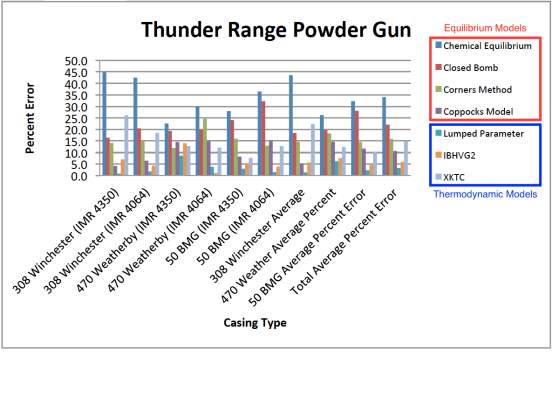
The simultaneous study of PTV (pressure, temperature, velocity) curves which is responsible for projecting the projectile out from the barrel, is a common representative approach to the analysis of the effect of models’ inputs. In the past, the conventional models were based on the chemical combustion reaction equilibriums inside the chamber. The outcomes of such models are quite insufficient to represent sophisticated MCSs, and only give overall performance of the gun. As Miner R said (Miner, 2008) “Closed form solutions are convenient because they give you a basis of what parameters are important and how they can affect the overall performance of the launcher.” A thesis has been written to compare wide range of conventional and thermodynamic models, Figure 3.1-1 illustrates the error percentage of experimented and simulated results between the conventional and thermodynamic models (Miner, 2008).
3.1.1 Properties of modern internal ballistics models
The new internal ballistic models are divided into two different categories, depending on the model approach of each one, lumped parameter and CFD (computational fluid dynamics) models. The principle of lumped parameter models is based on the thermodynamic behaviour of the gases behind the projectile. Theoretically, it is zero-dimensional representation which analyse the pressure distribution between the gun breech and the projectile base. Figure 3.1-2 (a) explains the difference between breech pressure pd and base pressure ps. On the other hand, the models of CFD have different concept of representing the internal ballistic behaviour, more clearly; they have the capability of multi-dimensional representation when different ignition and loading processes are applied, by taking the consideration of the axial and radial changes inside the gun. CFD type is divided to two methods (Gollan, Johnston, Flaherty, & Jacobs, 2007);
- Separated flow theory: forms averaging technique over two separated flow of gases.
- Continuum mixture theory: treats the gas flow as one continuum flow of mixtures.
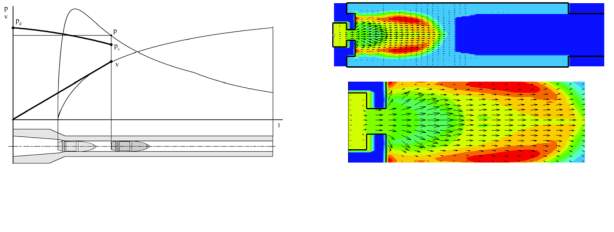
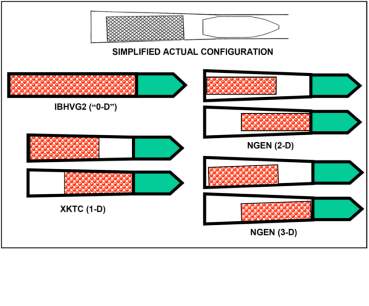
Presently, lots of models have been validated through DoDs or military agencies in Europe and US. Configurationally, 0D lumped parameter such as SNL, IBHVG2, and IBRGA (or called STANAG 4367); 1D axial change such as NGEN2 and XKTC; multi-D axial and radial change such as NGEN3 (Bougamra & Lu, 2014) consider different representations of the propellant charges that insure the sufficient muzzle velocity for each zone. The representation of different charges configurations are displayed in Figure 3.1-2.
3.1.2 Internal ballistics models as diagnostic tools
“The number of demotions is not the only factor that determine the applicability of a model” (Toit, 2001). The capability of each type lies on their mathematical formulation and the proportionality of the model inputs to the outputs. First, the generic uses of 0D IB models are to predict the global parameters such as maximum pressure and muzzle velocity; implying that, the performance of IB system can be determined by implementing this type of models . These predictions are due to the reliability of the model outcomes to the inputs. For example, the burn rate of propellant grains is indirectly proportional to the determination of the pressure inside the combustion chamber (Agrawal, 2010), r=βPn, where r is the burn rate of the propellant grains, β is the burn rate coefficient, P is the pressure generated by the burning, and n is the propellant composition constant.
0D models are the least accurate ones among the IB models but they are sufficient for sensitivity applications. Second, 1D models have the prediction capability as well with the ability to analyse the gases conductance within the gun chamber to identify potential overpressures. The results are more accurate but the complexity of the models is higher which may lead to add correction factors to the model. For instance, when the propellant grains get larger or smaller, variations may occur and result in inaccurate predications. This phenomenon is called interphase drag and can be reduced by manipulating charge configuration and adding some correction factors (C. R. Woodley, 2001). Lastly, as the models become more sophisticated, multi-D are more accurate as a result of representing both axial and radial movements within the chamber. The method is to use CFD theory, dividing the internal ballistic into number of meshes, and apply microscopic representation of different considerations.
A validation has been done on 40mm gun to compare the three different types of models and match the results with experimented firing values. Table 3-1 shows the results of the three models with comparison to firing data.
Table 3‑1: IB models comparison on 40 mm gun (C. Woodley et al., 2007)
| Experimented
(mean) |
0-D
SIBIL |
1-D
CTA1 |
Multi-D
FHIBS |
|
| Max breech pressure (MPa) | 428 | 561 | 463 | 443 |
| Max base pressure (MPa) | – | 439 | 357 | 328 |
| Muzzle velocity (m/s) | 1234 | 1340 | 1244 | 1246 |
| Shot exit time (ms) | – | 4.39 | 6.30 | 8.13 |
The results of 1-D and 2-D have delay values from the 0-D results which are caused by different considerations of the ignition processes. Consequently, the rapidity of these considerations is due to the interphase drags of each ignition representation. The error of the results shows 7.9%, 0.8% and 1% of 0-D, 1-D and multi-D receptively.
3.2 Sensitivity analysis to several ballistic parameters of MCS
The aspect of all-burnt point: It is the time the propellant takes to completely burn versus the time the projectile spends in the barrel. The burn rate of propellants is pressure dependent and with a fast burning propellant the burnout will occur too early and with a slower burning propellant it will occur too late. Any propellant that is unburned when the projectile exits the muzzle is wasted and transfers no energy to the projectile. It does, however, add to the recoil pressures and muzzle blast. For maximum energy transfer to the projectile with the resulting maximum muzzle velocity, the charges should burn out just before the projectile leaves the barrel. Overpressure that can’t be handled by the gun can be reached if all-burnt point occurs early, and if it occurs to fast it will not ensure the desired exit velocity. “Therefore, the ideal position for all-burnt is at point of one-third of the way up the bore” (DoD, 1992).
The variations of the internal ballistic parameters cause the all-burnt point to move outside the specs which leads to the system not to be accurate. Loading condition is the common customary when the charge’s parameters are designed to be changed. The department of defence of Canada published the approximation variation of these parameters to the maximum pressure and exit velocity for a typical IB system. Table 3-2 shows the causes of loading conditions to the outputs of the IB system.
Table 3‑2: Approximation variation due to charge in loading conditions (DoD, 1992)
| 1% increase in | % variation in muzzle velocity | % variation in maximum pressure | |
| Projectile weight | -0.40 | +0.60 | |
| Charge weight | +0.60 | +1.60 | |
| Chamber capacity | -0.25 | -1.15 | |
| Propellant size | -0.15 | -0.85 | |
Studies have been done by the DoD of Canada and the US Army Research Laboratories show the effective parameters causes to the accuracy of the IB system. These two studies explored variety of different IB parameters and will be reviewed in this section (DoD, 1992), (Schmidt, Nusca, & Horst, 2009). The sensitivity analysis of ARL has been experimentally done on 120 mm mortar gun (charge 2 and charge 4 only) with multi-D modelling code while the variation study which was done by DoD of Canada described the typical IB system.
The all-burnt point is the main objective to be achieved in order to maintain sufficient muzzle velocity with minimal peak pressure. The solid lines in the below graphs represents the P-t curve for the typical IB system while the dotted lines represent the P-t curves after loading condition of each parameter.
3.2.1 Charge weight
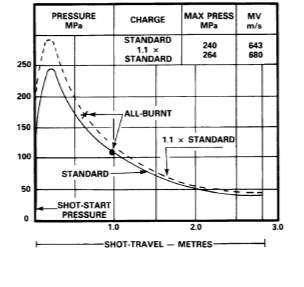
Naturally, if the charge weight increases, more gases will be released and increase the peak pressure of the combustion. As a result, the all-burnt point may be dragged back causing the propellant not to burn when the projectile leaves the gun (DoD, 1992). The sensitivity of the changing of the charges’ weights to the peak pressure and exit velocity is represented by correlations graphs (Schmidt et al., 2009). According to the results of DoD document, it is seen that the variations of the charge’s weight have the most influence among the other parameters.
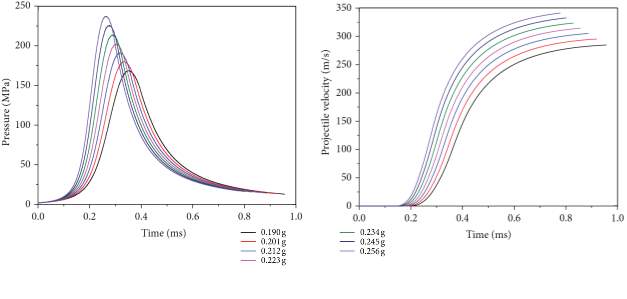
With the tolerance of 1.6 in the peak pressure and 0.6 in the exit velocity, the ratio can be manipulated to meet the desired specification. This means the higher the charge weight the higher the exit velocity with considering that it may reach the pressure limit of the gun. A parametric study has been covered on small arm calibre, 9 mm cartridge, with 2-D simulation model to analyse the effect of the charge mass to the IB outputs (Bougamra & Lu, 2014). PV-t curves are illustrated to describe variances of masses to the base pressures and the exit velocities in figure 3.2.1-2.
The results obtained by the study show linear correlation between the weight of the charge and maximum pressure and exit velocity. The executed code of this study has 5% error of the predicted muzzle velocity to the experimented result. Table 3.2.1 show the influence of changing propellant mass to the IB outputs for 9 mm gun.
Table 3.2.1: Effect of weight charge on IB performance (Bougamra & Lu, 2014)
| Solid propellant mass (g) | ||||||
| Min. | Max. | |||||
| 0.190 | 0.201 | 0.212 | 0.223 | 0.234 | 0.243 | |
| Max pressure (MPa) | 169.13 | 180.52 | 191.76 | 203.04 | 214.53 | 226.56 |
| Muzzle velocity (m/s) | 284.76 | 295.35 | 305.09 | 314.48 | 323.54 | 332.72 |
| Shot exit time (ms) | 0.957 | 0.920 | 0.887 | 0.857 | 0.829 | 0.802 |
3.2.2 Propellant size
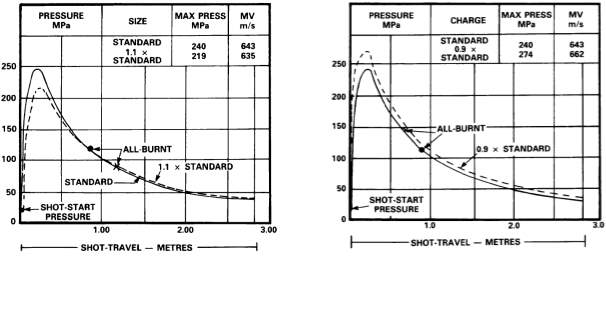
An increase in propellant size causes a decrease in total initial burning surface, a lower peak chamber pressure, the all-burnt point is further forward and muzzle velocity could be lower (DoD, 1992). From a ballistic viewpoint, the best propellant grain size is that which, with the smallest charge mass, will impart the required velocity to a projectile without exceeding the maximum pressure of the weapon system. A propellant composition and configuration that burns too fast (generates gas at a too rapid rate) creates a destructive pressure spike that usually has a very short duration. Using a propellant that burns too slowly produces poor energy transfer and leaves a lot of unburned propellant slivers.
A sensitivity study article has been written on 155 mm artillery gun to show the influence of the propellant grain size on the IB outputs. Table 3.2.2 displays the variations in percentage from the reference case values with max pressure of 163.1 MPa and exit velocity of 665.1 m/s. “variations of − 0.9% in the diameter of propellant grain result in variations of +2.8% in the maximum pressure and decrease of − 6.2% in the muzzle velocity” (Velasco, 2017).
Table 3.2.2: Effect of grain size on IB performance (Velasco, 2017)
| Size 1 | Size 2 | Size 3 | Size 4 | |||||
| Length & Diameter (mm) | L
11.46 |
D
5.46 |
L
10.86 |
D
5.50 |
L
11.25 |
D
5.47 |
L
11.60 |
D
5.55 |
| Max pressure (MPa) | 2.8 | 1.2 | 3.5 | 4.7 | ||||
| Muzzle velocity (m/s) | -6.2 | -6.6 | -5.7 | -5.3 | ||||
3.2.3 Propellant shape
For a single propellant grain, the number and size of the perforations (holes) of the are important dimensions in determining the gas generation rate and therefore the vivacity of a propellant. The vivacity of a propellant is the rate of gas generation per time unit. It is important to have a tight control of the propellant grain dimensions during the propellant manufacturing process to ensure similar gas generation for each one. DoD of Canada released the difference among cord, tubular and multi-perforations grains and how the peak pressure reduced and become flatter.
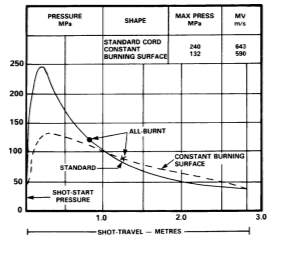
Another perspective of variation of the shape is when the dimensions of different grains vary within the same charge. Usually, any propellant charge uses same shape but with different perforations dimensions. This is due to failures in the manufacturing process of the propellant grains which cause different holes lengths. A study has been handled on 155 mm artillery gun, it is based on statistical analysis of varying the grain shape dimensions to observe the tolerances on the IB system outputs. The difference between perfect and non-perfect grains can be shown in table 3.2.3.
Table 3.2.3: Effect of shape variation on IB performance (Pocock, Locking, & Guyott, 2004)
| Perfect grains | Non-perfect grains | Difference | |
| Max pressure (MPa) | 378 | 368 | 2.5% |
| Muzzle velocity (m/s) | 875 | 856 | 2.0% |
3.2.4 Sensitivity correlation to different IB system parameters
Correlations of model inputs and outputs can be driven through complicated computational methods or even by statistical techniques to represent the influence of each input or combination of inputs to the model output. A sensitivity analysis has been done to determine the degree of effectiveness of the inputs to the outputs (Schmidt et al., 2009). Obviously seen, the most influence ballistic parameter to the peak pressure is the charge weight while the most one to the exit velocity is the burn rate exponent. This exponent is a propellant composition constant that is determined chemically. Whereas, the least influence ballistic parameter to the peak pressure is the force of the combustion reaction inside the gun chamber while the least influence ballistic parameter to the exit velocity is the burn rate coefficient.
With taking consideration of that the muzzle velocity is dependent output parameter, a special statistical technique is requested to analyse these correlations. Conclusively, the IB output functions which are represented by the vertical axis are function of the IB input parameters. The relationship among these parameters can be determined by many methods (e.g. regression coefficients).
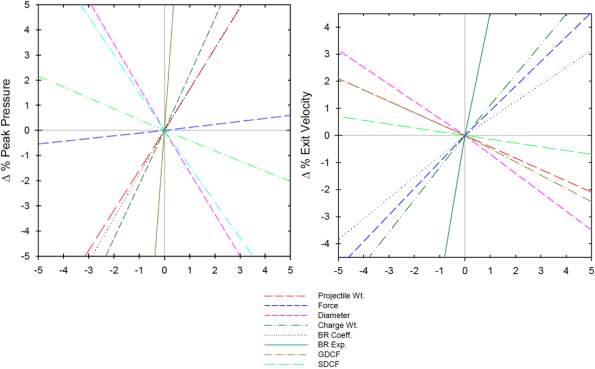
Figure 3.2.5: Sensitivity correlation to different IB system parameters
3.3 Methodological assumptions
From statistical point of view, the stochastic model can be constructed through the followed procedures:
3.3.1 Selection of appropriate PDF
The probability distribution function is unable to be defined without a historical study of data set of the model. Statistical tables and graphs of the historical data of the same input draw a figure of what PDF can be (Faber, 2012). Therefore, statistical features of these data representations are determined. EpiX Analytics LLC )http://www.epixanalytics.com( defined these features which are:
- Discrete or continuous variables.
- Bounded or unbounded ranges.
- Parametric or non-parametric values.
- Univariate or multivariate parameters.
- First or second order representations.
3.3.2 Evaluation of selected PDF
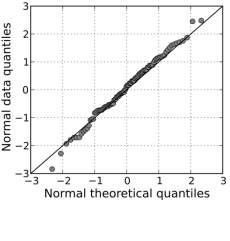
After selecting PDF, statistical techniques are used to test the suitability of the distribution function to the data sets of the model. The most plenty function that is suitable for most data sets is the normal distribution. As a result, first test to be implemented to the data set is probability normality test. This will tell to use such a function to be fitted to the stochastic model. Therefore, quantile plot technique is implemented in which real valued random variable is plotted against its CDF over standard distribution and a straight line is drawn through them. Thus, if the plotted points are widely spread it denotes that the standard deviation of the distributed function is not suitable for the corresponding data set. As well, if the intersection point of the drawn line and its vertical axis is not cantered it implies that the mean value is not convenient. (Faber, 2012). The analysis of the quantile paper can be used as an evaluation tool to accept any probability distribution.
3.3.3 Estimation of distribution parameters
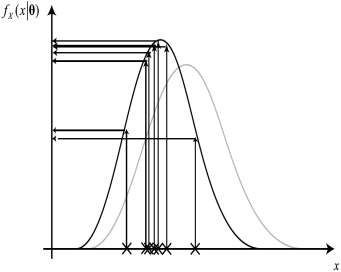
4 Research aim and objectives
The ballistic specifications of a Modular Charge System (MCS) is problematic during the early development phases, since the ballistic effect of all possible variations of the input variables cannot be validated by testing. By employing a stochastic input procedure to a reliable Internal Ballistic Simulation Model, the ballistic variation in output can be determined for the complete MCS and the ballistic input and output specifications can be derived from these simulations early in the development cycle and provide reliable results for the development effort.
The project will focus on the formulation of a relevant stochastic method to be applied. The system input variables and limits will be identified from experimental and manufacturing data and specifications. An Internal Ballistic Simulation Model Code will be adapted and applied to determine the relevant ballistic outputs.
4.1 Research aim
- To predict and determine MCS performance parameters.
- To develop ballistic specifications.
- To create guidelines for a follow-up study to address challenges identified in this study.
4.2 Research objectives
- Perform the necessary literature study in order to describe the typical ballistic system requirements of various ballistic systems as background.
- Research the applicable Stochastic Methods theory and develop a customised Stochastic Modelling tool on top of an applicable simulation model.
- Development of a customised Internal Ballistic Simulation Code with the capability of providing the input data for the Stochastic Model.
5 Research methodology
The benchmark of the deterministic model and the stochastic model structures lies on the availability of the data needed to come out with the adequate IB outputs. Therefore, only the most important system parameters will be defined and analysed to avoid any complexity. The design transacts with both qualification and quantification procedures; wherefore, the research design method will be mixed method.
5.1 Study context
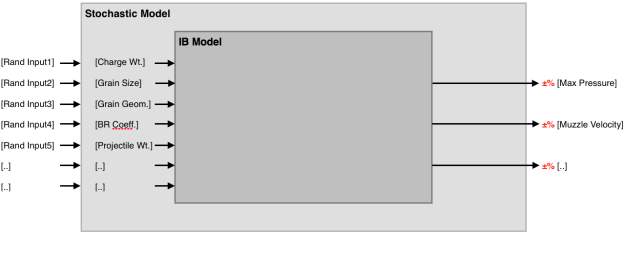
The substantial aspect of the design construction is the linkage of the IB model (deterministic model) and the probabilistic model (stochastic model). As a result, the inner IB model should be maintained separately in order to build robust design. First, appropriate IB will be defined and coded and its input parameters will be located. Second, random number generators will be linked to each IB parameter with defined probability parameters (e.g. mean and standard deviation). A process of OFAT (one-factor-at-a-time) will be maintained to observe the changes on the IB outputs. Third, variance-based method will be generated as the stochastic process is defined to tolerate the specifications of each output. Finally, quality characteristics will be observed and defined.
5.2 Data collection
- Regression analysis.
- Quality control and specifications
Ethical considerations
Keeping this knowledge with in the legitimate circle. Also, preventing it from been used by parties that do not respect national or international laws.
Permission and informed consent
Formal permission was taken from mentors and supervisors of development projects to test, analyse and gather data for validation purposes.
Anonymity
This research study proposal was recommended by Mr. Victor Schabort who have previous experience in the field. He acts as a study guide for this research proposal and his previous unpublished work must be noticed.
Confidentiality
Confidentiality of test data must be kept as required. Intellectual property as respected and sited as required. Other people contributions also must be noticed as sited in the report.
References
Agrawal, J. P. (2010). High Energy Materials: Propellants, Explosives and Pyrotechnics.
Bougamra, A., & Lu, H. (2014). Multiphase CFD Simulation of Solid Propellant Combustion in a Small Gun Chamber, 2014.
DoD. (1992). Artillery Ballistics and Ammunition (Vol. 6).
Faber, M. H. (2012). Statistics and Probability Theory.
Gollan, R. J., Johnston, I. A., Flaherty, B. T. O., & Jacobs, P. A. (2007). Development of Casbar : a Two-phase Flow Code for the Interior Ballistics Problem, (December), 295–302.
Horst, A. W., & Nusca, M. J. (2006). The Charge Designer ’ s Workbench : A Range of Interior Ballistic Modeling Tools, (May).
Miner, R. T. (2008). Computational Interior Ballistics Modeling.
Pocock, M. D., Locking, P. M., & Guyott, C. C. (2004). EFFECT OF STATISTICAL VARIATION IN GRAIN GEOMETRY ON INTERNAL BALLISTICS MODELLING.
Schmidt, J. R., Nusca, M., & Horst, A. W. (2009). Mortar Interior Ballistics: Sensitivity Studies Using IBHVG2 and Progress Toward a Multidimensional Representation, (June).
Toit, D. (2001). A Two-Dimensional Internal Ballistics Model for Modular Solid Propellant Charges. Control, (May), 7–11.
Velasco, F. J. S. (2017). One-Dimensional Modelling of Internal Ballistics. Journal of Energetic Materials, 0(0), 1–24. https://doi.org/10.1080/07370652.2016.1265613
WikipediaContributors. (2017). Q–Q plot.
Woodley, C., Carriere, A., Franco, P., Nussbaum, J., Chabaux, X., & Longuet, B. (2007). COMPARISONS OF INTERNAL BALLISTICS SIMULATIONS OF 40MM GUN FIRINGS.
Woodley, C. R. (2001). COMPARISON OF 0D AND 1D INTERIOR BALLISTIC MODELLING OF HIGH PERFORMANCE DIRECT FIRE GUNS, (May), 7–11.
This dissertation proposal has been written by a student and is published as an example. See our guide on How to Write a Dissertation Proposal for guidance on writing your own proposal.
Cite This Work
To export a reference to this article please select a referencing stye below:
Related Services
View allRelated Content
All TagsContent relating to: "Sciences"
Sciences covers multiple areas of science, including Biology, Chemistry, Physics, and many other disciplines.
Related Articles
DMCA / Removal Request
If you are the original writer of this dissertation proposal and no longer wish to have your work published on the UKDiss.com website then please:




